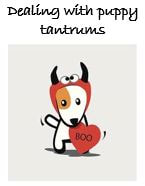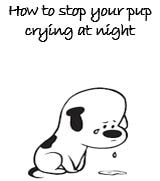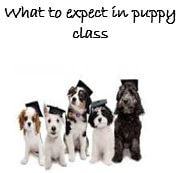Guidelines for puppy exercise
Thank you - www.puppyculture.com - for sharing this!
Thank you - www.puppyculture.com - for sharing this!
One of the worst things you can do for pups, is to overexercise them, or exercise them in the incorrect manner.
In addition to having soft growth plates at the end of long bones, a puppy’s bones in general are “softer.” Dogs, like people, don’t reach their maximum bone density until after puberty.
Spiral fractures of the tibia (lower leg bone) are very common in puppies - 50% of all fractures occur in puppies under 1 year of age. A spiral fracture is where the bottom half of the bone twists in one direction and the top half twists in the other.
This kind of juvenile injury is known as “Toddler Fracture” in humans, and it’s thought to be caused by the fact that the outside, fibrous layer of the bone (periosteum) is relatively strong in relation to the elastic bone inside. So any exercise that puts torque on (twists) a bone puts the puppy at risk for a fracture.
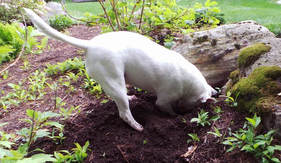 Never underestimate the value of a good digging session. Consider digging up a soft patch in a corner of your yard and burying “doggy treasures” in it - great natural exercise for your puppy!
Never underestimate the value of a good digging session. Consider digging up a soft patch in a corner of your yard and burying “doggy treasures” in it - great natural exercise for your puppy!
Self Directed Play is an overriding rule for any puppy under 18 months old. The majority of his exercise should be free play, exploring, and noodling around. If he shows any fatigue, flops down, refuses to walk, you should listen to him and let him rest.
Probably the biggest cause of growth plate and soft tissue injury is repetitive exercise with a young puppy. So, until he’s about 18 months old, long hikes and walks are out and lots of free-play sessions are in.
Repetition is your Enemy
Probably the biggest cause of growth plate and soft tissue injury is repetitive exercise with a young puppy. So, until he’s about 18 months old, long hikes and walks are out and lots of free-play sessions are in.
Sniff and Stroll
While long hikes are out, just tooling around in the backyard with you is great. If you don’t have a backyard, short, rambling walks are perfect. Let your puppy sniff, explore and take it at his own pace. You can intersperse short training sessions in your walks to work on heeling/loose leash walking, but the majority of the walk should be at your puppy’s own pace and at his discretion.
Speaking of hikes, if you’re an outdoorsy type of person, you should bring your puppy along on hikes - its great socialization for puppies under 12 weeks old, and great enrichment for older puppies. But just like when you take a small child on a walk, be prepared to carry your puppy a good portion of the way. If you’re jogging or walking on a manicured trail or paved park road, consider investing a puppy stroller to put your tyke in for most of the walk.
Trail Blazing
Kibble trails are also a great way to tire out a puppy both mentally and physically. Remember, dogs generally don’t naturally go on long “marches” - they tend to noodle around and stop and sniff a lot as they go. Kibble trails allow puppies to stay outside a long time and cover a lot of ground in a very natural way.
Play with a well-matched and gentle playmate is ideal. Size is a factor, as a very large dog, especially one that likes to play with a lot of paw whacks, can inadvertently injure a young or small breed puppy.
That being said, a gentle Wolfhound may be a better playmate than a feisty Jack Russell Terrier who likes to body slam. Keep a very careful eye out and be prepared to throw handfuls of cookies down to interrupt any overly physical play. Body slams and crazy rolls are spiral fractures waiting to happen!
Probably the biggest cause of growth plate and soft tissue injury is repetitive exercise with a young puppy. So, until he’s about 18 months old, long hikes and walks are out and lots of free-play sessions are in.
Repetition is your Enemy
Probably the biggest cause of growth plate and soft tissue injury is repetitive exercise with a young puppy. So, until he’s about 18 months old, long hikes and walks are out and lots of free-play sessions are in.
Sniff and Stroll
While long hikes are out, just tooling around in the backyard with you is great. If you don’t have a backyard, short, rambling walks are perfect. Let your puppy sniff, explore and take it at his own pace. You can intersperse short training sessions in your walks to work on heeling/loose leash walking, but the majority of the walk should be at your puppy’s own pace and at his discretion.
Speaking of hikes, if you’re an outdoorsy type of person, you should bring your puppy along on hikes - its great socialization for puppies under 12 weeks old, and great enrichment for older puppies. But just like when you take a small child on a walk, be prepared to carry your puppy a good portion of the way. If you’re jogging or walking on a manicured trail or paved park road, consider investing a puppy stroller to put your tyke in for most of the walk.
Trail Blazing
Kibble trails are also a great way to tire out a puppy both mentally and physically. Remember, dogs generally don’t naturally go on long “marches” - they tend to noodle around and stop and sniff a lot as they go. Kibble trails allow puppies to stay outside a long time and cover a lot of ground in a very natural way.
Play with a well-matched and gentle playmate is ideal. Size is a factor, as a very large dog, especially one that likes to play with a lot of paw whacks, can inadvertently injure a young or small breed puppy.
That being said, a gentle Wolfhound may be a better playmate than a feisty Jack Russell Terrier who likes to body slam. Keep a very careful eye out and be prepared to throw handfuls of cookies down to interrupt any overly physical play. Body slams and crazy rolls are spiral fractures waiting to happen!
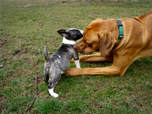
Be a Puppy Matchmaker
Play with a well-matched and gentle playmate is ideal. Size is a factor, as a very large dog, especially one that likes to play with a lot of paw whacks, can inadvertently injure a young or small breed puppy.
That being said, a gentle Wolfhound may be a better playmate than a feisty Jack Russell Terrier who likes to body slam. Keep a very careful eye out and be prepared to throw handfuls of cookies down to interrupt any overly physical play. Body slams and crazy rolls are spiral fractures waiting to happen!
Soft Landings
Jumping off of beds and couches are major causes of spiral fractures in puppies - we are constantly on guard until our puppies reach two years old and keep them off furniture and beds unless we’re there to help them off. We also use heavy carpet pads and carpets around all furniture and beds to cushion impact, should a young (or old) dog slip by and get up on a high piece of furniture.
You can start training in agility but no jumping higher than wrist height until 6 months old, no jumping higher than elbow height until 18 months old.
Play with a well-matched and gentle playmate is ideal. Size is a factor, as a very large dog, especially one that likes to play with a lot of paw whacks, can inadvertently injure a young or small breed puppy.
That being said, a gentle Wolfhound may be a better playmate than a feisty Jack Russell Terrier who likes to body slam. Keep a very careful eye out and be prepared to throw handfuls of cookies down to interrupt any overly physical play. Body slams and crazy rolls are spiral fractures waiting to happen!
Soft Landings
Jumping off of beds and couches are major causes of spiral fractures in puppies - we are constantly on guard until our puppies reach two years old and keep them off furniture and beds unless we’re there to help them off. We also use heavy carpet pads and carpets around all furniture and beds to cushion impact, should a young (or old) dog slip by and get up on a high piece of furniture.
You can start training in agility but no jumping higher than wrist height until 6 months old, no jumping higher than elbow height until 18 months old.
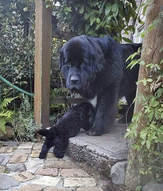
Stairs Aren't Hip
A study of 500 Newfoundland, Labrador, and Leonberger puppies found that puppies who climbed flights of stairs daily before they were 3 months of age had an increased risk of developing hip dysplasia. Although these breeds were selected for the study because of their relatively high incidence of hip dysplasia, the study seems to indicate that stairs represent a strain on any puppy’s joints, so consider ramps or carrying your puppy down stairs if possible.
Be Early Over Hill and Dale
Interestingly, the same study found that off-leash self-directed exercise on gently rolling, varied, and moderately soft ground for puppies under 3 months old decreased the risk of developing hip dysplasia.
And it’s important to get that exercise in early-free play after 12 weeks old, while certainly beneficial in general, was not shown to decrease the risk of hip dysplasia in the study. So, once again, self-directed play in your backyard or garden is the best exercise for young puppies.
Play Nice
Puppies often have more “will” than “way” when it come to chasing toys and will not stop until they are literally on top of the toy, causing both heavy impact and twisting on the bones and soft tissue. We advise rolling balls or dragging toys on the ground for all puppies. Tug toys should be held low and steady - don’t pull up or back on your puppy’s neck!
A study of 500 Newfoundland, Labrador, and Leonberger puppies found that puppies who climbed flights of stairs daily before they were 3 months of age had an increased risk of developing hip dysplasia. Although these breeds were selected for the study because of their relatively high incidence of hip dysplasia, the study seems to indicate that stairs represent a strain on any puppy’s joints, so consider ramps or carrying your puppy down stairs if possible.
Be Early Over Hill and Dale
Interestingly, the same study found that off-leash self-directed exercise on gently rolling, varied, and moderately soft ground for puppies under 3 months old decreased the risk of developing hip dysplasia.
And it’s important to get that exercise in early-free play after 12 weeks old, while certainly beneficial in general, was not shown to decrease the risk of hip dysplasia in the study. So, once again, self-directed play in your backyard or garden is the best exercise for young puppies.
Play Nice
Puppies often have more “will” than “way” when it come to chasing toys and will not stop until they are literally on top of the toy, causing both heavy impact and twisting on the bones and soft tissue. We advise rolling balls or dragging toys on the ground for all puppies. Tug toys should be held low and steady - don’t pull up or back on your puppy’s neck!
|
Many owners think it is rather cute when their pups first offer a temper tantrum when they don’t get their own way, and the most common one I would see in puppy class is when the owner picks the pup up when it is busy playing with the other pups or the play escalates - if only you knew!
|
Let's put ourselves in our pups shoes (paw's?) for a second. This little bundle of fluff has been taken away from it's mom and litter mates, very often without being prepared for the separation at all- no wonder it is crying! Here are some tips to help you through this period.
|
Not all puppy classes can offer all of these activities, but a good puppy class should be able to provide the bulk of them.
|



